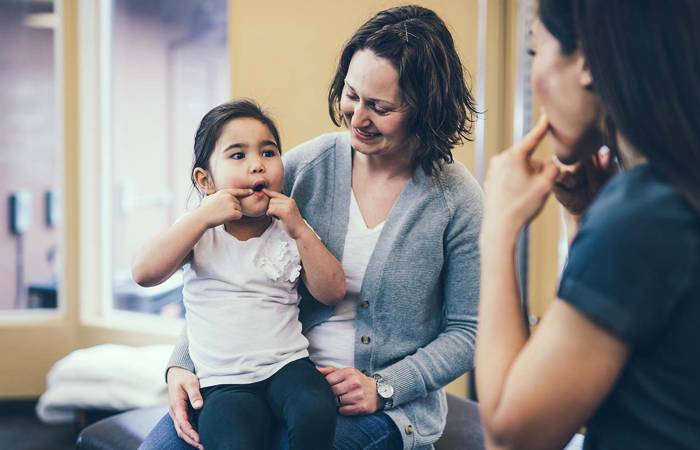Like what you see?
Sign up to receive more free parenting advice.
Thank you for subscribing to our newsletter!
Child Development

Credit: iStock.com/quintanilla
A breakthrough in identifying a potential cause of apraxia, the most severe child speech impediment, by the Murdoch Children’s Research Institute, may help develop more targeted treatments for children.
Apraxia is often associated with a history of early feeding difficulties and limited babbling in the first year of life. From 12 months onwards, children have delayed first words and they also pick up new words very slowly.
One in 1000 children has apraxia, but understating the origins of this debilitating speech disorder has until now remained elusive.
A team of researchers, led by MCRI speech pathologist Professor Angela Morgan, has identified anomalies in a key speech pathway of the brain connected to speech.
Professor Morgan, who is also Professor of Speech Pathology at the University of Melbourne, says children with apraxia fail to learn to speak clearly and combine sounds properly, while the timing and sequencing of their words are also affected.
She says that by age three, children should be easily understood by family and friends when speaking. If your child is not able to be understood by these familiar listeners, it suggests they could have a speech disorder.
People struggle to understand what they say, which has major negative long-term effects on their ability to form social relationships, self-esteem, academic achievements and quality of life.Professor Angela Morgan
Stay up to date with the latest news and articles from First Five Years
Thank you for subscribing to our newsletter!
Signs and symptoms of apraxia
Professor Morgan says the signs and symptoms of apraxia start early.
“It may be reported that they have used a word but then seem to ‘lose’ that word, or that they don't say the word in the same way each time. Children find speaking so difficult that they often rely on pointing or gestures to get their message across. Children with apraxia may appear to really struggle to get the words out. It is clear that talking is really not an easy task for them,” she says.
“People struggle to understand what they say, which has major negative long-term effects on their ability to form social relationships, self-esteem, academic achievements and quality of life.”
Professor Morgan says the research team was able to identify irregularities in a core brain pathway in apraxia sufferers.
“Normal MRI scans found no anomalies, but we used a very sophisticated scan, that enables Brain Tractography analysis, which measures the integrity of brain pathways,” she says.
“We looked at the brains of seven families members with apraxia and found there were core differences in a key brain tract for speech – the dorsal language stream.”
Professor Morgan says this newly discovered variance in that brain pathway appears to be critical to how people listen and then produce speech.
Potential for more targeted treatments
She says the MCRI team’s research helps better understand apraxia which may assist neuroscientists and speech pathologists to develop targeted treatments such as drug therapies.
“Our research examines the underlying cause of apraxia. Why does apraxia occur? Changes, or mutations, in a number of genes have been linked to apraxia. Changes in genes are thought to lead to altered brain development of the brain pathways supporting speech,” Professor Morgan says.
“In our study, we found differences in the development of a particular language pathway in the brain that seems to have led to apraxia. This pathway is understood to link auditory (what we hear) information with movement information (how we move our articulators to produce speech).
“Into the future, pairing genetic and brain information will help develop more targeted therapies, such as drug therapies to target the biological pathways disrupted by specific gene changes, trying to mitigate changes in brain development to prevent speech disorder.
“Current therapies are only based on treating the speech errors, which we can think of as symptoms on the surface of the body.
“We have some therapies that work well, when applied intensively by the family and therapist working together.”
Common speech problems
Professor Morgan says most speech challenges are overcome in the preschool years.
The most common forms of speech sound disorder are articulation and phonological delays or disorders.
“An articulation disorder is best described when we think about a lisp on the sound 's'. In an articulation disorder, the child is making an approximation of the correct sound, but the sound is slightly distorted as it is not made in exactly the right way,” Professor Morgan says.
“Whereas a phonological disorder is best described as when children do not understand which sounds to use in which positions in words. Children with phonological disorders tend to 'swap' sounds around, such as ‘tup’ for ‘cup’, or even omit sounds from the beginning or ends of words, like ‘do’ for ‘dog’.
“Some of these errors are typical in all young children under four years of age, and most children simply grow out of these error patterns.
“Where a speech problem is more persistent, or if parents and family are unable to understand the child at age three, perhaps they should seek help from a speech pathologist if they are concerned.”
Professor Morgan says apraxia is diagnosed by a speech pathologist.
The speech pathologist conducts a series of speech tasks that probe whether the child has developed all the sounds of their language, and whether they can use these sounds correctly.
“They are also looking to see whether the child has more common forms of speech disorder, such as articulation and phonological disorders, or whether the child has more significant error patterns as seen in apraxia.
“It is challenging to diagnose apraxia in younger children who may not have as much language. In these instances, a watch and wait approach is often used, until the therapist is certain that the child does have ‘praxis’ issues (problems planning and implementing speech), rather than just delayed language development or other concerns.”
Professor Morgan says apraxia often co-occurs with other developmental challenges, such as body movement problems, learning challenges or ADHD.
“When apraxia occurs largely on its own, the prognosis is more positive,” she says.
“Children with apraxia typically attend mainstream schools. They need a lot of intensive speech therapy in the early to mid-school years.
“Most children are largely intelligible by the teenage years, but may have the persistence of some error patterns or may struggle with more complex words and phrases.
“Children with apraxia may also experience written and spoken language problems, which have further impacts in the school environment.”
The research paper, Dorsal language stream anomalies in an inherited speech disorder is published in the latest issue of the international journal, Brain.







